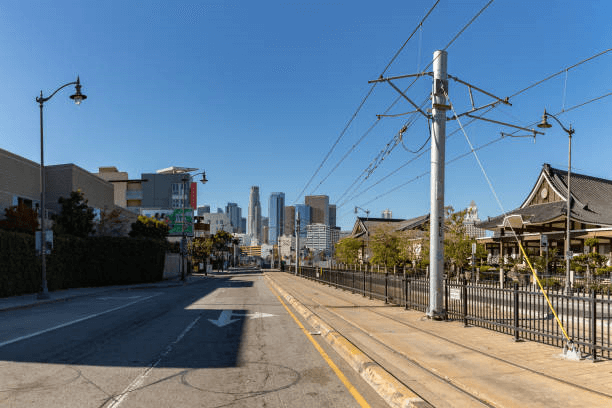Honoring Valor and Housing Needs: Groundbreaking Project in Los Angeles' Little Tokyo
In a significant step towards addressing both the critical need for affordable housing and commemorating the valor of American soldiers of Japanese ancestry during World War II, a groundbreaking project has commenced in Los Angeles' Little Tokyo district. This mixed-use complex, known as the First North Residences and the Go For Broke Plaza, promises to provide essential housing units while serving as a permanent home for the Go For Broke National Education Center (GFBNEC), a nonprofit dedicated to educating the public about the courage and sacrifices of Japanese-American soldiers.
 Rendering Courtesy of the Little Tokyo Service Center (LTSC)
Rendering Courtesy of the Little Tokyo Service Center (LTSC)and Go For Broke National Education Center (GFBNEC)
The centerpiece of the project is its 248 affordable housing units, including 80 permanent supportive units for unhoused individuals, with a special focus on homeless veterans. Situated amidst legacy businesses and iconic establishments such as the Fugetsu-do Confectionary and Suehiro Cafe, the development will also feature approximately 40,000 square feet of community-serving retail space along Jackson Street, ensuring the preservation of Little Tokyo's rich cultural heritage and fostering economic vitality.
At the heart of the complex lies the Go For Broke Plaza, a tribute to the brave soldiers of the 100th/442nd Regimental Combat Team and the Military Intelligence Service, who fought valiantly in World War II despite facing discrimination and prejudice at home. Embracing the existing Go For Broke monument, the plaza serves as a reminder of the resilience and determination of Japanese-American soldiers, whose motto "Go For Broke" encapsulated their unwavering commitment to victory.
Preserving Heritage: A Chronicle of Real Estate History in Los Angeles' Little Tokyo
Little Tokyo stands as a testament to resilience, culture, and community spirit. As one of the city's most cherished neighborhoods, its history is deeply intertwined with the evolution of real estate, reflecting the trials and triumphs of generations past. In this article, we embark on a journey through time to explore the rich tapestry of real estate history in Little Tokyo, tracing its origins, challenges, and enduring legacy.
The story of real estate in Little Tokyo begins in the late 19th century when Japanese immigrants first settled in the area, drawn by opportunities in agriculture, fishing, and trade. Initially concentrated around First Street and Central Avenue, the neighborhood quickly grew into a vibrant community, with businesses, homes, and cultural institutions taking root amidst the bustling cityscape. As demand for housing and commercial space surged, real estate developers played a pivotal role in shaping the landscape of Little Tokyo, laying the groundwork for its future growth and prosperity.
Throughout the early 20th century, Little Tokyo flourished as a thriving cultural and economic hub, serving as a beacon of opportunity for Japanese Americans seeking to build a better life. Despite facing discrimination and prejudice, residents and business owners persevered, establishing thriving businesses, religious institutions, and social organizations that became integral parts of the community fabric. Real estate transactions during this period reflected the resilience and determination of Little Tokyo's residents, as they navigated challenges and seized opportunities to secure their place in the neighborhood.
The post-World War II era brought significant changes to Little Tokyo, as urban renewal projects and redevelopment initiatives reshaped the neighborhood's physical landscape. While these efforts aimed to modernize and revitalize the area, they also led to the displacement of many longtime residents and businesses, sparking debates about preservation and gentrification. Real estate transactions during this period reflected the tensions between progress and preservation, as developers sought to balance economic interests with community needs and historical preservation.
In recent decades, efforts to preserve Little Tokyo's cultural heritage and empower its residents have become increasingly prominent. Community organizations, advocacy groups, and local leaders have worked tirelessly to protect historic landmarks, promote affordable housing, and foster economic development that benefits longtime residents and businesses. Real estate transactions have played a crucial role in these efforts, as stakeholders collaborate to strike a balance between preserving the past and embracing the future of Little Tokyo.

As Little Tokyo continues to evolve, the legacy of its real estate history serves as a guiding force for future development and growth. With a renewed focus on cultural preservation, community empowerment, and inclusive economic development, stakeholders are working together to ensure that Little Tokyo remains a vibrant and resilient neighborhood for generations to come. By honoring the past while embracing the future, real estate in Little Tokyo will continue to play a central role in shaping the identity and destiny of this cherished community.
A New Chapter
With a total development cost of approximately $168 million, this project represents a significant investment in both affordable housing and historical preservation. By creating much-needed housing units and honoring the legacy of Japanese-American soldiers, the First North Residences and the Go For Broke Plaza embody the values of compassion, resilience, and remembrance, ensuring that their contributions to history are never forgotten. As construction progresses, the project stands as a testament to the enduring spirit of Little Tokyo and its commitment to building a brighter future for all.



